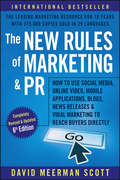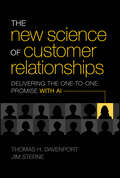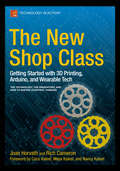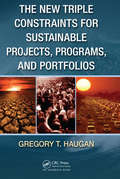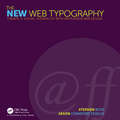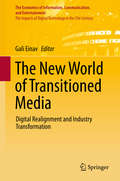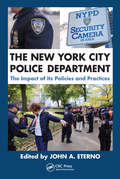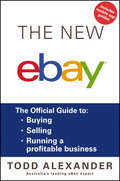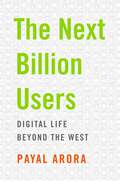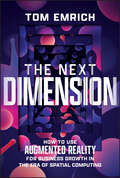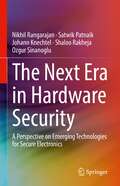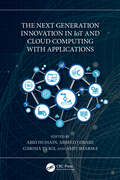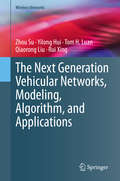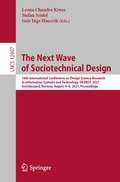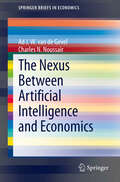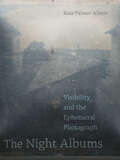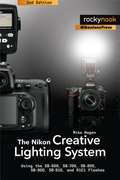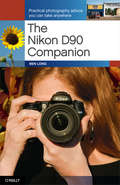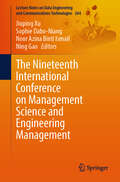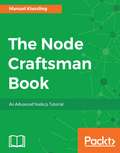- Table View
- List View
The New Rules of Marketing and PR: How to Use Social Media, Online Video, Mobile Applications, Blogs, Newsjacking, and Viral Marketing to Reach Buyers Directly
by David Meerman ScottThe international bestseller—now in a new edition When it comes to marketing, anything goes in the Digital Age, right? Well, not quite. While marketing and public relations tactics do seem to change overnight, every smart businessperson knows that it takes a lot more than the 'next big thing.' The New Rules of Marketing & PR is an international bestseller with more than 375,000 copies sold in twenty-nine languages. In the latest edition of this pioneering guide to the future of marketing, you'll get a step-by-step action plan for leveraging the power of the latest approaches to generating attention for your idea or your business. You'll learn how get the right information to the right people at the right time—at a fraction of the cost of traditional advertising. The Internet continues to change the way people communicate and interact with each other, and if you're struggling to keep up with what's trending in social media, online videos, apps, blogs, or more, your product or service is bound to get lost in the ether. In The New Rules of Marketing & PR, you'll get access to the tried-and-true rules that will keep you ahead of the curve when using the latest and greatest digital spaces to their fullest PR, marketing, and customer-communications potential. Keeping in mind that your audience is savvy and crunched for time, this essential guide shows you how to cut through the online clutter to ensure that your message gets seen and heard. Serves as the ideal resource for entrepreneurs, business owners, marketers, PR professionals, and non-profit managers Offers a wealth of compelling case studies and real-world examples Includes information on new platforms including Facebook Live and Snapchat Shows both small and large organizations how to best use Web-based communication Finally, everything you need to speak directly to your audience and establish a personal link with those who make your business work is in one place.
The New Science of Customer Relationships: Delivering the One-to-One Promise With AI
by Thomas H. Davenport Jim SterneA practical strategy guide for building profitable customer relationships using the latest AI science and tech The New Science of Customer Relationships: Delivering the One-to-One Promise with AI is a science-based and insightful new approach to integrating the latest generative AI technologies into your company's customer communications. Analytics and marketing experts Thomas Davenport and Jim Sterne walk you through the technology and tools you need to understand, the data you need to collect, the processes you need to implement, and the ethics you need to observe to build an industry-leading customer relationship framework. In the book, you'll learn to create systems that reliably generate smart, persuasive, and hyper-personalized interactions with your company's best customers. You'll also discover how to integrate these systems directly into your firm's existing operations so you can use the tools to realize tangible financial results. Inside the book: Tips for using generative AI to analyze customer responses and extract actionable insights about how they feel and what they think Specific tools and technologies you can use to collect customer data and conduct effective analytics to improve your products and services Discussions of ethical guidelines to guide your organization's data and customer communication practices Perfect for marketers, sales team leaders, technology professionals, and anyone else responsible for evolving their company's customer relationships, The New Science of Customer Relationships is a hands-on playbook that explains the science of the latest customer communication technologies and walks you through exactly how to implement them.
The New Shop Class
by Joan Horvath Rich CameronThe New Shop Class connects the worlds of the maker and hacker with that of the scientist and engineer. If you are a parent or educator or a budding maker yourself, and you feel overwhelmed with all of the possible technologies, this book will get you started with clear discussions of what open source technologies like 3D printers, Arduinos, robots and wearable tech can really do in the right hands. Written by real "rocket scientist" Joan Horvath, author of Mastering 3D Printing, and 3D printing expert Rich Cameron (AKA whosawhatsis), The New Shop Class is a friendly, down-to-earth chat about how hands-on making things can lead to a science career. Get practical suggestions about how to use technologies like 3D printing, Arduino, and simple electronics Learn how to stay a step ahead of the young makers in your life and how to encourage them in maker activities Discover how engineers and scientists got their start, and how their mindsets mirror that of the maker What you'll learn What all of the big "maker" technologies are, what they can do, and how to get more information Why scientists, citizen scientists, and makers do what they do -- and how they do what they do Why breaking things is as important as making things How portrayals of science differ from the real world How to encourage the young scientists and makers in your life, or become one yourself What scientists and makers can learn from each other Who this book is for Aspiring scientists, makers, teachers, students, and anyone who wants a guide to the vast and expanding world of makers and their tools and inventions. Table of Contents Front Matter: Featuring a Foreword by Coco Kaleel, Mosa Kaleel, and Nancy Kaleel Part 1. The Technologies Chapter 1. 21st Century Shop Teacher Chapter 2. Arduino, Raspberry Pi, and Programming Physical Things Chapter 3. 3D Printing Chapter 4. Robots, Drones, and Other Things that Move Part 2. Applications and Communities Chapter 5. Makerspaces and Hackerspaces Chapter 6. Citizen Science and Open Source Labs Chapter 7. Cosplay, Wearable Tech and the Internet of Things Chapter 8. Circuits and Programming for Kids Chapter 9. Open Source Mindset and Community Chapter 10. Creating Female Makers Chapter 11. Making at a Community College and Beyond Part 3. How Scientists Get Started Chapter 12. Becoming a Scientist Chapter 13. How Do Scientists Think? Chapter 14. What Do Scientists Do All Day? Part 4. Tying It All Together Chapter 15. Learning by Iterating Chapter 16. Learning Science by Making Chapter 17. What Scientists Can Learn from Makers Appendix: Links
The New Street Photographers Manifesto: Any Camera, Anywhere
by Tanya NagarWhether you shoot with a digital SLR, a Holga or the camera on your phone, today's cameras let you seize the moment and shoot whenever and wherever you like. This makes them perfect for street photography, the genre of choice of some of the greatest photographers of all time, with names like Henri Cartier-Bresson, Weegee and Robert Frank turning gritty reality into iconic images.In this book, Tanya Nagar will open your eyes to the photographic potential of your urban world environment, offering the tricks and techniques that put you in the right place, at the right time, and let you create amazing photos. In addition to everything that'll give you the right skills and headspace to capture great images on the street, Nagar has brought together a stunning showcase of some of the greatest emerging street photographers of our age to inspire you.
The New Triple Constraints for Sustainable Projects, Programs, and Portfolios
by Gregory T. HauganThe ongoing changes in population, climate, and the availability of energy have resulted in unprecedented threats and opportunities that all project and program managers, portfolio managers, and public planners need to be aware of. The New Triple Constraints for Sustainable Projects, Programs, and Portfolios offers a clear look at how these constra
The New Web Typography: Create a Visual Hierarchy with Responsive Web Design
by Stephen Boss Jason Cranford TeagueWith a vast selection of typefaces now available, there is no excuse for using boring typography in web design. The New Web Typography: Create a Visual Hierarchy with Responsive Web Design shows you how to implement web-safe fonts to create visually appealing and multi-browser-friendly websites while encouraging you to develop designs that express your own unique typographic voice. <P><P>This book discusses general principles for choosing typefaces for on-screen display and tips for creating a visual hierarchy that works on monitors, tablets, and smartphones. It shares some of the authors’ personal experiences to illustrate situations where one font would be more effective than another in giving readers an optimized experience that includes quick download times and an overall aesthetically pleasing presentation. <P><P>Since good typography is good web design, font selection is a critical aspect of web design. The New Web Typography is more than a simple overview of web typography. It provides practical advice and examples that help you make good decisions in choosing fonts for web design. <P><P>Key Features <li>Demonstrates how to implement responsive web typography, with up-to-date HTML5 and CSS3 code <li>Uses case studies and examples to enhance instruction <li>Provides practical tips on special techniques for implementing webfonts and searching and using webfont libraries <li>Encourages you to develop a unique typographic voice
The New World of Transitioned Media
by Gali EinavThe media industry is undergoing an accelerated pace of change, driven in large part by the proliferation of digital platforms. In many cases, the speed of adoption has exceeded our ability to process the impact of these changes on individuals and society at large. This book provides a "behind-the-scenes" look at the media industry's transition into the digital era and examines its impact on marketing, advertising, innovation and other economic and social activities. The impact of digital technologies on traditional media sectors, such as advertising, video games, film and television is well-documented. Less understood is its effect on our perceptions, thought processes and inter-personal relationships. Social media, for example, represents a fundamental change in the ways we interact with media, communicate with each other and even present ourselves to the world. This has shaped the way we communicate with institutions and brands. Similar to the first "Transitioned Media" book, Transitioned Media: A Turning Point into the Digital Realm, this book combines media industry leaders and academics to explore various transformative trends and issues. Themes include measuring cross-platform behaviour, artificial intelligence in journalism, the evolution of video games, digital media and physical space, the mobile use trends, social media and the corporate world, the changes in the television and newspaper business and the evolving relationship between advertisers and target audiences. The varied backgrounds of contributors and array of topics make for a unique and insightful point of view.
The New York City Police Department: The Impact of Its Policies and Practices
by John A. EternoStudying the flagship New York City Police Department is critical to understanding policing and democratic society. An examination of the department by experts who have been studying it for years, The New York City Police Department: The Impact of Its Policies and Practices provides a frank and open discussion about the NYPD from an elite group of scholars with varying viewpoints and concerns. The authors in this book are uniquely qualified to discuss and analyze the intricacies of policies and their impact.
The New ebay: The Official Guide to Buying, Selling, Running a Profitable Business
by Todd AlexanderThe only comprehensive, official guide to buying and earning money on eBay Australia Written by an eBay insider with more than ten years of experience with the company, The New eBay guides you through the very basics to the more complicated--from a brief history of eBay itself to simple site navigation to every complexity of buying and selling. <P><P>Whether you just want to earn a few dollars on the side or turn your hobby into a full-time business, this book explains it all. Written in clear, user-friendly language backed by simple step-by-step instructions and helpful screen grabs from the site, the book covers everything first-timers need to know and all the secrets experienced sellers wish they knew. The first complete official guide for eBay Australia written by a company insider Covers such topics as finding items and bidding on them, pricing and listing items for sale, accepting payments, tracking sales, logistics, customer service, and more Perfect for every eBay user, from part-timers to serious sellers who want to build a profitable business, The New eBay is the ideal guide for anyone who wants to get the most out of the world's most popular shopping and selling site.
The New iPad Fully Loaded
by Alan HessMaximize all that the new iPad has to offer with The New iPad Fully Loaded! The new iPad Fully Loaded is a one-of-a-kind resource for squeezing every bit of functionality from your new iPad. Whether you're downloading content of any sort, looking to get the most out of iOS5, or using your new iPad to control anything from your home stereo system to your vehicle, nothing is out of the realm of possibilities. As you progress through this captivating, full-color book, veteran author Alan Hess takes you beyond the basics and show you how to fully utilize your new iPad and it's impressive features. Peppered with sophisticated tips and tricks, The new iPad Fully Loaded encourages you to modify your new iPad to your own specifications and teaches you never-before-revealed tricks so that you can truly get the most out of this amazing device. Goes beyond the basics to deliver rare tips and tricks on maximizing all that the new iPad has to offer Includes tips, tricks, and techniques that are applicable to every version of the iPad Covers new benefits of iOS 5 Boasts updates on the latest iPad technology developments as well as coverage of both common and uncommon tasks In full-color and sporting a convenient trim size, The new iPad Fully Loaded is the perfect accessory to your new iPad.
The Next Billion Users: Digital Life Beyond the West
by Payal AroraWhy do citizens of states with strict surveillance care so little about their digital privacy? Why do Brazilians eschew geo-tagging on social media? What drives young Indians to friend “foreign” strangers on Facebook and give “missed calls” to people? Payal Arora answers these questions and many more about the internet’s next billion users.
The Next Dimension: How to Use Augmented Reality For Business Growth In The Era of Spatial Computing
by Tom EmrichYour guide to transforming your business with spatial computing, featuring real use cases and proof points of augmented reality in marketing, advertising, and sales Ready to revolutionize your business? The Next Dimension: How to Use Augmented Reality For Business Growth In The Era of Spatial Computing, by Tom Emrich, explores the power of augmented reality (AR) to propel your business strategy into the next wave of computing. Learn how AR is reshaping the digital landscape, crafting a new marketing mix, and evolving retail into a brand-new consumer experience. Gain valuable insights on realizing success with AR across the marketing funnel, activate and engage ‘Generation AR,’ and move beyond traditional ads with immersive campaigns that are co-created with your consumer. With real-world examples from brands like LEGO, BMW, Walmart, Gucci, Diageo, and more, this guide equips you with everything you need to use AR technology for immediate and impactful results. What's Inside? Game-Changing Benefits: Spatial Computing 101: Get introduced to the future of computing. Understand how spatial computing transforms our relationship with technology and uncover the new opportunities it offers for your business. Your 3D Wakeup Call: Learn to spatialize your business by embracing 3D. Discover the latest consumer devices and develop a 3D strategy that maximizes your investment across consumer touchpoints. Marketing in an Augmented World: Explore how brands seamlessly integrate AR into their marketing mix. Dive into common mobile AR use cases and see how brand pioneers are marketing with mixed reality headsets like Apple Vision Pro and Meta Quest 3. Advertising in the Next Dimension: Break free from traditional banner ads with immersive AR campaigns. Learn to digitize print and out-of-home advertising and get a glimpse of future opportunities with smartglasses. Selling with Spatial Computing: Revolutionize e-commerce into AR-commerce by bringing showrooms to customers and making online shopping feel more tangible. Use AR to turn a trip to the store into an unforgettable experience. Why The Next Dimension is Your Must-Have Guide: Groundbreaking Insights: Tom Emrich demystifies cutting-edge technology, breaking it down into simple, actionable steps that make AR accessible and exciting for everyone. Real-World Success Stories: Immerse yourself in inspiring case studies from pioneering brands leveraging AR platforms from Meta, Snap, TikTok, Niantic, and more. These include data points demonstrating how AR achieves results from awareness to purchase. Actionable Roadmaps: Receive detailed, practical guidance on effectively integrating AR, covering everything from innovative marketing tactics to measurement considerations. Future-Proof Your Career: Ramp up your knowledge, gain inspiration, and find out how to develop an AR-centric strategy to stay ahead in this ever-evolving tech landscape. The Next Dimension is more than a book; it's your key to unlocking the digital frontier. Become a spatial computing champion and help take yourself and your business to the forefront of this technology. Bonus for book owners: This book is AR-activated. Bring the cover to life with a WebAR experience created by EyeJack. PLUS, talk to an AI about this book with ‘The Next Dimension Book GPT.’
The Next Era in Hardware Security: A Perspective on Emerging Technologies for Secure Electronics
by Ozgur Sinanoglu Nikhil Rangarajan Satwik Patnaik Johann Knechtel Shaloo RakhejaThis book provides a comprehensive coverage of hardware security concepts, derived from the unique characteristics of emerging logic and memory devices and related architectures. The primary focus is on mapping device-specific properties, such as multi-functionality, runtime polymorphism, intrinsic entropy, nonlinearity, ease of heterogeneous integration, and tamper-resilience to the corresponding security primitives that they help realize, such as static and dynamic camouflaging, true random number generation, physically unclonable functions, secure heterogeneous and large-scale systems, and tamper-proof memories. The authors discuss several device technologies offering the desired properties (including spintronics switches, memristors, silicon nanowire transistors and ferroelectric devices) for such security primitives and schemes, while also providing a detailed case study for each of the outlined security applications. Overall, the book gives a holistic perspective of how the promising properties found in emerging devices, which are not readily afforded by traditional CMOS devices and systems, can help advance the field of hardware security.
The Next Frontier of Restaurant Management: Harnessing Data to Improve Guest Service and Enhance the Employee Experience (Cornell Hospitality Management: Best Practices)
The Next Frontier of Restaurant Management brings together the latest research in hospitality studies to offer students, hospitality executives, and restaurant managers the best practices for restaurant success. Alex M. Susskind and Mark Maynard draw on their experiences as a hospitality educator and a restaurant industry leader, respectively, to guide readers through innovative articles that address specific aspects of restaurant management:* Creating and preserving a healthy company culture* Developing and upholding standards of service* Successfully navigating guest complaints to promote loyalty* Creating a desirable (and profitable) ambiance* Harnessing technology to improve guest and employee experiences* Mentoring employeesMaynard and Susskind detail the implementation of effective customer management and staff training, design elements such as seating and lighting, the innovative use of data to improve the guest experience, and both consumer-oriented and operation-based technologies. They conclude with a discussion of the human factor that is the foundation of the hospitality industry and the importance of a healthy workplace culture. As Susskind and Maynard show, successful restaurants don't happen by accident.
The Next Generation Innovation in IoT and Cloud Computing with Applications
by Amit Sharma Ahmed J. Obaid Abid Hussain Garima TyagiThe Next Generation Innovation in IoT and Cloud Computing with Applications is a thought-provoking edited book that explores the cutting-edge advancements and transformative potential of the Internet of Things (IoT) and cloud computing. This comprehensive volume brings together leading experts and researchers to delve into the latest developments, emerging trends, and practical applications that define the next era of technological innovation.Readers will gain valuable insights into how IoT and cloud computing synergize to create a dynamic ecosystem, fostering unprecedented connectivity and efficiency across various industries. The book covers a wide spectrum of topics, including state-of-the-art technologies, security and privacy considerations, and real-world applications in fields such as healthcare, smart cities, agriculture, and more.With a focus on the future landscape of technology, this edited collection serves as a pivotal resource for academics, professionals, and enthusiasts eager to stay at the forefront of the rapidly evolving IoT and cloud computing domains. By offering a blend of theoretical perspectives and hands-on experiences, The Next Generation Innovation in IoT and Cloud Computing with Applications serves as a guide to the forefront of technological progress, providing a roadmap for the exciting possibilities that lie ahead in this era of connectivity and digital transformation.
The Next Generation Vehicular Networks, Modeling, Algorithm and Applications (Wireless Networks)
by Tom H. Luan Zhou Su Yilong Hui Qiaorong Liu Rui XingThis book proposes the novel network envisions and framework design principles, in order to systematically expound the next generation vehicular networks, including the modelling, algorithms and practical applications. It focuses on the key enabling technologies to design the next generation vehicular networks with various vehicular services to realize the safe, convenient and comfortable driving. The next generation vehicular networks has emerged to provide services with a high quality of experience (QoE) to vehicles, where both better network maintainability and sustainability can be obtained than before.The framework design principles and related network architecture are also covered in this book. Then, the series of research topics are discussed including the reputation based content centric delivery, the contract based mobile edge caching, the Stackelberg game model based computation offloading, the auction game based secure computation offloading, the bargain game based security protection and the deep learning based autonomous driving. Finally, the investigation, development and future works are also introduced for designing the next generation vehicular networks.The primary audience for this book are researchers, who work in computer science and electronic engineering. Professionals working in the field of mobile networks and communications, as well as engineers and technical staff who work on the development or the standard of computer networks will also find this book useful as a reference.
The Next Generation of Distance Education
by Jason B. Huett Leslie MollerThe world of education is being radically altered with the change being driven by technology, openness, and unprecedented access to knowledge. Older correspondence-style methods of instructional delivery are passé and "classroom adapted to the web" approaches to learning are often ineffective and do little to harness the transformational potential of technology. E-Learning scenarios, mobile technologies, communication and information access, and personal learning environments are becoming mainstream and, as a result, control of the learning process is shifting away from institutions and into the hands of learners. This volumes promotes a forward-thinking agenda for research and scholarship that highlights new ideas, deep insights, and novel approaches to "unconstrained" learning.
The Next Wave of Sociotechnical Design: 16th International Conference on Design Science Research in Information Systems and Technology, DESRIST 2021, Kristiansand, Norway, August 4–6, 2021, Proceedings (Lecture Notes in Computer Science #12807)
by Stefan Seidel Leona Chandra Kruse Geir Inge HausvikThis book constitutes the thoroughly refereed proceedings of the 16th International Conference on Design Science Research in Information Systems and Technology, DESRIST 2021, held in Kristiansand, Norway, in August 2021.*The 24 revised full research papers, included in the volume together with 6 short contributions and 7 prototype papers, were carefully reviewed and selected from 78 submissions. They are organized in the following topical sections: impactful sociotechnical design; problem and contribution articulation; design knowledge for reuse; emerging methods and frameworks for DSR; DSR and governance; the new boundaries of DSR.*Apart from the planned on-site event, the hybrid conference model was explored due to the Covid-19 pandemic.
The Nexus between Artificial Intelligence and Economics
by Ad J. van de Gevel Charles N. NoussairThe manuscript reviews some key ideas about artificial intelligence, and relates them to economics. These include its relation to robotics, and the concepts of synthetic emotions, consciousness, and life. The economic implications of the advent of artificial intelligence, such as its effect on prices and wages, appropriate patent policy, and the possibility of accelerating productivity, are discussed. The growing field of artificial economics and the use of artificial agents in experimental economics is considered.
The Night Albums: Visibility and the Ephemeral Photograph
by Kate Palmer AlbersWe live in an era of abundant photography. Is it then counterintuitive to study photographs that disappear or are difficult to discern? Kate Palmer Albers argues that it is precisely this current cultural moment that allows us to recognize what has always been a basic and foundational, yet unseen, condition of photography: its ephemerality. Through a series of case studies spanning the history of photography, The Night Albums takes up the provocations of artists who collectively redefine how we experience visibility. From the protracted hesitancies of photography’s origins, to conceptual and performative art that has emerged since the 1960s, to the waves of technological experimentation flourishing today, Albers foregrounds artists who offer fleeting, hidden, conditional, and future modes of visibility. By unveiling how ephemerality shapes the photographic experience, she ultimately proposes an expanded framework for the medium.
The Nikon Creative Lighting System
by Mike HagenMike Hagen opens up a whole new world to those photographers who are already well versed in photography, but may not have a clue about flash photography. With the new and rapidly evolving technology, flash photography (especially advanced light modeling with modern iTTL flash systems) has become an art in itself and should be mastered by all aspiring photographers-amateurs as well as professionals-who are often helpless when it comes to using the full potential of these systems. Using a simple, step-by-step method for setting up and using the newest Nikon iTTL flash units, Mike teaches all the steps required to achieve consistent and amazing flash photos. He solves the common frustrations associated with flash, and specifically teaches how to use the SB-600, SB-700, SB-800, SB-900, SB-910, and R1C1 strobes. Also included is a chapter showing system configuration so readers can duplicate the desired results on their own. Beginning at a basic level and progressing to more advanced techniques, Mike teaches you everything you need to know about mastering Nikon's iTTL flash system.
The Nikon D90 Companion: Practical Photography Advice You Can Take Anywhere
by Ben LongThrough easy-to-follow lessons, this handy book offers a complete class on digital photography, tailored specifically for people who use the Nikon D90. This is not your typical camera guide: rather than just show you what all the buttons do, it teaches you how to use the D90's features to make great photographs-including professional-looking images of people, landscapes, action shots, close-ups, night shots, HD video, and more. With Ben Long's creative tips and technical advice, you have the perfect, camera-bag-friendly reference that will help you capture stunning pictures anywhere, anytime. The Nikon D90 Companion will show you how to: Take creative control and go beyond automatic settings Learn the basic rules of composition Capture decisive moments, including fast-moving objects Discover ways to use a flash indoors and outdoors Learn about different lenses, and the best time to use them Understand the options for shooting RAW, and whether it's right for you Use the D90's ability to shoot high definition video
The Nineteenth International Conference on Management Science and Engineering Management (Lecture Notes on Data Engineering and Communications Technologies #264)
by Jiuping Xu Sophie Dabo-Niang Noor Azina Binti Ismail Ning GaoThis is the proceedings of the Nineteenth International Conference on Management Science and Engineering Management (ICMSEM 2025). The Program Committee Chairs which are famous scientists in the area of management science and engineering management, and Program Committee Members which are active scholars from all over the world will review the submissions and select high quality papers to be published in the proceedings. ICMSEM provides a platform for researchers and practitioners of Management Science, Engineering Management and Engineering Science, to share ideas, exchange experiences. ICMSEM encourages papers that have following five elements: (1) strong background of practical management problem found in engineering practice; (2) clear problem description, and abstract it as a class of problem in Management Science and Engineering Management, topics such as decision analysis, manufacturing management, engineering project management, knowledge management, logistics, supply chain management, service innovation and management as well as a variety of multi-class interdisciplinary research; (3) effective mathematical engineering modelling, for example, creating engineering mathematical model and conducting abstract engineering mathematical analysis by using statistical mechanics, operations research, systems science, differential equations, variational inequalities, control theory, econometrics; (4) algorithm framework design, namely designing of algorithm model for solving engineering problems successfully; (5) successful application or case study in Engineering Management to show its scientificity and effectiveness. The proceedings of the Nineteenth ICMSEM cover a wide range of areas including hot management issues in Engineering Science. It provides newest and frontier ideas and research achievements in the area of Management Science and Engineering Management to researchers and practitioners. The work contains both theoretical and practical studies of Management Science in the Computing Methodology, showing the advanced management concepts, computing technologies for decision making problems with large, uncertain and unstructured data. Research in this proceeding will show the new changes and challenges in the decision-making procedure as we have entered the big data era. Theoretical studies of this proceedings will present the new technologies of analysis, capture, search, sharing, storage, transfer, visualization, and privacy violations, as well as advances in integration of optimization, statistics and data mining. This proceeding also contains practical studies in the real decision-making scenarios when facing large, uncertain or unstructured data. The readers who are interested in related fields of can benefit from the proceedings for the new ideas and research direction.
The Node Craftsman Book
by Manuel KiesslingBecome a Node.js craftsman. About This Book • This book will help readers to dive deeper into software development with Node.js and JavaScript • Takes a craftsman approach to Node.js and object-orientation and test-driven development • Crafts many of the small details of Node.js and through to fully-fledged web applications with REST Who This Book Is For This book is written to help you if you're working with Node.js already, but you want to move your craft to the next level with Node.js, so some working knowledge of Node.js is of course already assumed, so that we can look at the work of crafting applications with Node. What You Will Learn • How to connect to databases like MongoDB and MySQL from your Node.js application • How to unit tests and end-to-end tests for your code • When and how to leverage migrations for setting up a continuous deployment workflow • Detailed insight into how the Node Package Manager, NPM works • How object-orientation actually works in JavaScript • Ways to keep your code fast and efficient using asynchronous and non-blocking operations • How to use and create event emitters • How to use REST frameworks to write full-fledged web applications • How to integrate Node.js with Angular In Detail The Node Craftsman Book helps JavaScript programmers with basic Node.js knowledge to now thoroughly master Node.js and JavaScript. This book dives you deeper into the craft of software development with Node.js and JavaScript, incuding object-orientation, test-driven development, database handling, web frameworks, and much more. The Node Craftsman Book shows you how to work with Node.js and how to think deeply about how you build your Node projects. You'll master how to build a complete Node.js application across six crafting milestones, and you'll learn many specific skills to achieve that mastery. These skills include how to work with the Node Package Manager in depth, how to connect your Node applications to databases, and how to write unit tests and end-to-end tests for your code. You'll experience the full Node.js development picture, and learn how to craft and control your Node.js applications - right through to fully-fledged web applications using REST, and integration with Angular applications. Style and approach This book builds on your early knowledge and experience of Node.js and takes a craftsman approach to understanding the whole picture more deeply and shaping your Node applications to perform the way a craftsman would want. So, we take a thoughtful and broad thinking and coding approach to work with Node.js in this book.
The Non-Designer's Web Book: An Easy Guide to Creating, Designing, and Posting Your Own Web Site
by Robin Williams John TollettExplains the basics in a non-intimidating style and an easy-to-follow format, offering tips, techniques, and inspiration as well as numerous examples of what to avoid, on topics such as navigation, interfaces, graphic file format, image preparation, and animation, while explaining how to test, upload, register, and promote effective Web sites.
